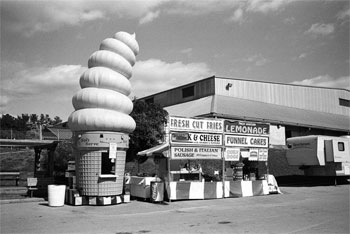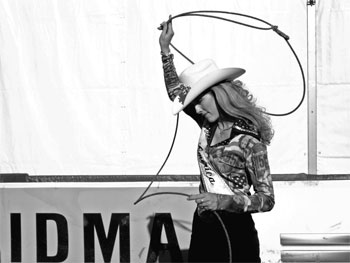When I first came to live in the United States early in 1979 I made a large part of my living shooting for European, mostly British, magazines. I was fortunate that at the time there was a great deal of interest in America and things American, and so I toured the country doing stories on Sun City in Arizona, cheerleading camps in Connecticut, the Pritikin Center in California, and Macdonald's Hamburger U in Chicago. I did a few serious stories for them, but mostly the subject was, "What have those wild and whacky Americans been up to now?"
It was fun in the beginning, but as I got to understand the country better it became irritatingly dissatisfying, because it was a distinctly superficial look at a remarkably complex society, and it was the complexities that I began to find intriguing. Yes, on one level it's silly to call a training center for fast-food restaurant managers a university and to award them a degree in hamburgerology, but the training that they received was actually pretty good. For one thing they had a concept of service instilled into them that was, and still is, woefully lacking in Great Britain. I came to love the nuttiness and eccentricities, because to me it was a product of a remarkably free and open society where people feel they have the right to try anything, and very few of their fellow citizens will chastise them for it.
 |
North Carolina State Fair (Raleigh), 2003: Food stands await customers in outlying area of fairgrounds by horse arena. Arthur Grace |
There is a line in Arthur Grace's own introduction to his recently published book
State Fair that sums up a lot of what I feel about the land that I now call home: "It was that oddly American juxtaposition of the heartfelt and the huckstering, the totally weird and the comfortably familiar, the love of country and the love of self, the individualism and the mass marketing that made the extravaganza of the state fair compelling to me." All countries go beyond their stereotypes, but no other country that I know transcends them more than America. It is so easy for the casual observer to think that he or she understands the United States while missing the layers of information, and countless clues that lie below the surface. Fortunately for us Arthur Grace is no casual observer, and out of the years that he spent photographing these uniquely American celebrations he has produced a document that mines the deeper seams of the nation's psyche.
State fairs were begun in the mid-19th century, initially as a sort of farmers' conference where the men who worked the land would gather to see the latest machinery, hear about the latest agricultural techniques, and show off their prize animals and produce. In America, anywhere that people gather other people will try and sell them stuff, from patent medicines to dubious machines whose purveyors make even more dubious claims as to their amazing qualities. Also because it's America, it isn't enough to show off your prize animals; you have to compete them against your neighbor's. And then, of course, again because it's America, you have to have food, lots of it, and entertainment. Many of the elements that were part of the early state fairs remain today, and in their own ways are key to understanding their continuing appeal to the people who flock to them every year.
The one element that Grace's photography cannot bring us is the noise. The screams of the fairgoers on the Top Spin Ride are muted, and neither do we hear the sounds of commerce from the tents, where, according to Grace during a recent interview, "they're selling everything from super-absorbent mops to vibrating machines that will make you lose weight or cure back pain. The din inside these places is deafening with people doing pitches; their microphones are on and they're talking as fast as they can. You hear the clack-clack of the credit-card imprint machines going back and forth and there's just an energy in there of selling, of capitalism, of entrepreneurism and of hucksterism, which is uniquely American."
 |
Colorado State Fair (Pueblo), 2004: Miss Rodeo America 2004, Darci Robertson, warms up for lassoing demonstration with children. Arthur Grace |
What we do get from his camera is a look at the strange, the quirky and the downright weird aspects of these gatherings. Whether it's the butter-sculpting contest, a goat dressed up as a tank in the animal costume competition, or the watermelon seed-spitting tournament, Grace has captured them all. Many take on a certain surreal quality, none more so than the veterinary operating theater set up inside one of the tents at the Minnesota State Fair by the local Veterinary Medical Association. Here at 10 a.m., 12 noon, 2 p.m. and 4 p.m., veterinarians give live demonstrations of cat spaying, the close-up details of which are transmitted to a large TV screen for the benefit of the audience. Even for the photographer initiated into the ways of state fairs this seemed a little unusual: "This to me is off-the-wall; I couldn't believe it when I heard of it. I stayed and didn't really watch it, but the stands are filled." If you add to this alligator wrestling, log rolling, balancing on one leg on a bucket, and a long-haired Chihuahua waiting to receive the Outstanding Therapy Dog award while dressed in leathers and sunglasses and perched on a miniature Harley Davidson, then you will understand how state fairs redefine the word bizarre.
Although my former editors at the British magazines would be delirious with delight, Arthur Grace takes a more sanguine view of these eccentricities: "What we might consider esoteric activities, off-the-wall activities, fringe activities, don't seem to be so for people going to the fair. They have a college bowl for rabbits where 4H teams compete in what they call a Rabbit Bowl, and answer questions about the care, feeding and breeding of rabbits. They're really serious, and their parents are in the stands cheering them on just like they're on TV. They dress in white shirts with bandanas, and it's a very serious business to them." Although many of the photographs are very funny, none are at the expense of the subject. The reason for this is that the photographer is entranced by the strangeness: "You go into these things as a photographer, and it's very easy to fall into the trap of being cynical, of taking cheap shots. I've never been able to do it because I like things that are humorous or strange, or off-the-wall photographically."
 |
Kansas State Fair (Hutchinson), 2004: Pie-tasting judge scrutinizes entries during Pillsbury Refrigerated Pie Crust Contest. Arthur Grace |
One of the major features of state fairs that Grace skirts around is food and its constant companion, obesity. The food is excessive and does not come with the American Medical Association Seal of Approval. "Everybody is told, 'Don't eat this one, it's too much fat; don't eat that one, it's bad for you,'" he says, "but when you go to a fair everyone has a big smile and they're eating cotton candy, deep-fried twinkies, and corn dogs and just blowing it out and forgetting about it, like before the time when everyone was warning you about cholesterol and everything else. Everyone seems to enjoy being 'bad.'" Many fairs have golf carts to assist people who are too obese to get around on their own. There are contests for baking pies and contests for eating them, and yet the only food-related shots in the book are one of a rather effete judge holding a plastic fork during the Pillsbury Refrigerated Pie Crust Contest, and a suitably sized competitor in the State Fair of Texas Corny Dog-eating challenge (a corny dog, or corn dog, is a hot dog on a stick, dipped in batter and deep-fried. It's not for the faint-of-heart – literally!). The reason for this scant coverage of an important part of the events is that Grace refuses to make fun of the people in front of his lens, and he says, quite correctly, that it is difficult to photograph somebody eating. You can make people look stupid or funny eating, but you can't take a good photograph of them as they indulge in it. These are photographs that don't stimulate the photographer, "So what, there's fat people eating; it's not a picture to me. A fat person I would take, but a fat person in a golf cart just stuffing their face is not interesting to me. It's obvious. Okay, so they're fat, they're eating."
It is the respect for the attendees at state fairs that adds depth to Grace's photography. The photographs are funny, but they're not trivial. If somebody in Malaysia in 50 or 100 years' time wants to know what America was like at the turn of the century, then State Fair will be an excellent source for them to understand the people and their values, for, like it or not, these are normal Americans. They are patriotic, militaristic, sentimental, independent, community-minded and, under the circumstances of the fair, remarkably tolerant. However one hopes that the reader of the future, and indeed, to some extent, the reader today, has the ability to adjust their normalcy compass. There is an unreal Alice Through the Looking Glass quality to the photographs, and a sense of nostalgia. Grace readily admits this: "The state fair isn't what goes on in the real world in America. When you walk in the gate you're in a place where time stands still and everybody's there to have fun, have a good time and to relax. It's where we leave behind all the stress and the demands on us from work, from politics, and from everything else, but it's not real. People are on their best behavior; people are there to have fun; people smile at each other; people talk to each other. Unfortunately when most people get up in the morning and go to work, that's not what's going on. They're worried about their kids and what's going to happen at school, and about the news and terrorism and their jobs, and that's stress and pressure."
In a world where Paris Hilton earns a minimum of $5,000,000 a year while the base pay for a high school teacher is under $40,000, where we spend $9.4 billion dollars a year on cosmetic surgery and at the same time over 10 million children in our country lack basic health insurance, who is to say what is normalcy, or if what is normal is also commendable? Maybe the appeal of the state fair is that it is a kinder, gentler America where the worst thing that can happen to you is to fall off the bucket upon which you were balancing on one leg. I asked Arthur Grace what he hoped to achieve with the book. His reply: "I want the book to show the reader that we live in a strange and diverse land. I think there's something very strange about this country; we all know it; we all sense it; we all see it. But strange doesn't have to be a negative. We're very diverse, and there's room for everybody with different ideas of what's interesting to them, what's fun for them to do, and where their efforts should be directed, and that's kind of what this country has always been about."

